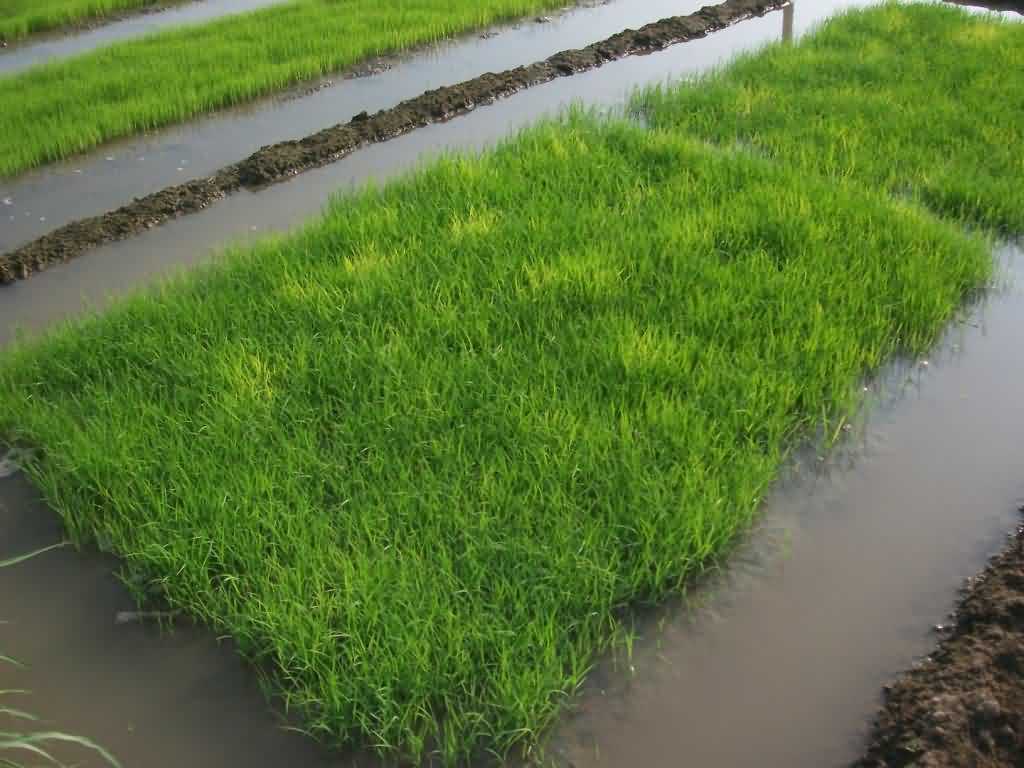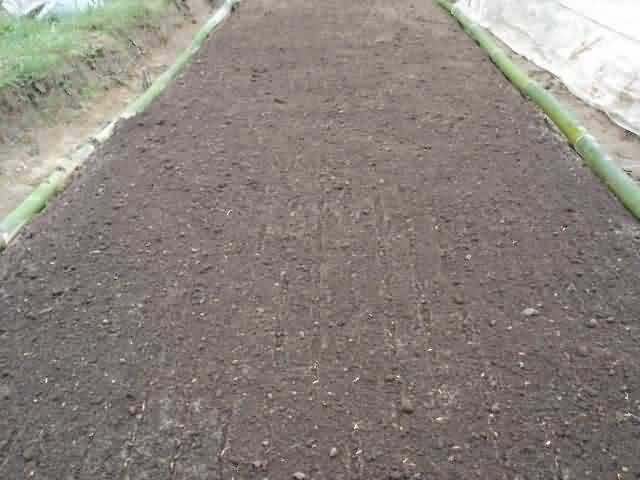धान की पौध तैयार करनें के 4 उन्नत तरीके
Rice which is to be transplanted into lowland puddled soil must first be nursed on seedbeds. The main reason for nursing rice is simple: to give the seedlings a substantial head start on weeds.
Four types of nurseries are commonly used:
The wet bed nursery, The dry bed nursery, The “dapog”. And the SRI system . Each type has advantages and disadvantages, and you will probably end up using different nursing methods depending on the situation.
Always keep in mind that it is really very easy to raise healthy seedlings if you are prepared to take enough time to do the job properly. Success in raising healthy rice seedlings depends mainly on constant supervision of the seedbeds and proper management.
1. The Wet Bed Nursery
The nursing of rice seedlings by the wet bed method is carried out on raised beds within the field. Select a fertile, level plot with good water control. Soil preparation, should always be very thorough. At least one ploughing and a careful puddling are necessary to loosen the soil as well as to facilitate the decomposition of organic matter.
The addition of organic material to plots designated as nursery areas can help ensure seedling vitality, provided it is added early enough to decompose completely.
After soil preparation is completed, peg out the nursery bed with bush poles and string. The beds should be approximately one meter (1m) wide. The relatively narrow width ensures that any area within the bed can easily be reached from either side.
Leave alleyways of approximately 40 cm between the beds for use later as irrigation channels. Scoop soil from the alleyways by hoe or by hand to construct the beds, which eventually should be raised 10 cm above the original surface of the plot.
Work through the raised soil with your fingers, breaking up clumps and removing sticks, roots, and stones (this will facilitate uprooting the seedlings later on). Finally, smooth the surface of the bed using a board or your flattened hand.
Broadcast pre-germinated seed on the beds, being sure to achieve an even distribution. It is very important not to space the seeds too close, as they will crowd each other out when they begin to grow.
An application rate of five (5) pounds /10m bed gives excellent results. When the seeds have been sown, smooth over them with your hands to cover with a thin layer of soil. This will help protect them against heavy rain or birds. In some cases it will also be necessary to cover the newly-sown beds with banana leaves, grass, or brush.
It is extremely important to keep the beds moist at all times. Although water is usually not a problem with the wet bed, make sure to check the nursery at least twice a day. If it is not raining every day, moisten the beds morning and evening by splashing water up from the irrigation channels between the beds.
Seedlings in the wet bed nursery can be attacked by insects, although pest infestation is generally not a big problem (if it is, encourage the farmer to make subsequent beds toward the centres of the swamp, away from the brushy peripheries where insects breed). If it becomes necessary to resort to the use of a chemical pesticide, do not spray until the seedlings are at least five days old.
The seedlings should be ready for transplanting after 14 days, depending on the variety and the conditions. Younger seedlings are always preferable as they establish themselves more quickly.
The "fourth leaf" stage is generally regarded as optimal. Remember to flood the beds completely beforehand (submerge the soil, not the rice) to minimize damage to the seedlings.
Uproot seedlings by holding a few at a time and pulling sideways. Always handle seedlings with extreme care. Seedlings which are handled gently during uprooting and transporting recover much more quickly when transplanted than those which are crushed, bruised, or allowed to dry out.

Wet bed system of rice nursery raising
Advantages of the wet bed nursery:
- Situated right in the field
- Irrigation water readily available
- Seedlings grow rapidly seedlings easy to uproot
- Minimal disease and pest problems
- Excellent for dry season crops
2. The Dry Bed Nursery
Select a level or gently sloping area near a convenient water source. Plow and harrow the soil twice to obtain a fine till. At least 10-15 cm of topsoil must be opened up and well pulverized. Addition of decomposed organic matter and/ or partially burned rice straw or rice husks will help keep the soil aerated and will make it easier to uproot the seedlings.
Peg out the beds in the same manner as wet beds. Scoop soil from the alleyways, using a hoe or shovel. Level the beds and crush any remaining clods by hand or with a stick. Broadcast the pre-germinated seed just as you would on a wet bed.
The application rate should be similar: five (5) pounds/10m bed is good. Be careful to cover the seeds completely with a thin layer of soil. If heavy rains or birds threaten, cover the beds with fronds or leaves.
The beds should be watered thoroughly, immediately after planting and twice every day thereafter. Soak the bed well (to near saturation). If irrigation water is available, water can be sent along the channels and splashed onto the beds, otherwise water must be carried in by hand.
It is impossible to overemphasize the importance of constantly watering dry bed nurseries. Seedlings growing on wet beds can usually absorb sufficient water from below the surface, but dry bed seedlings are totally dependent on rain and hand watering.
If the beds dry out for even one day, the growth of the seedling may be seriously impaired. Do not encourage a farmer to construct dry bed nurseries unless he can be depended on to water them regularly.
Dry bed seedlings will not grow as fast as wet bed seedlings. Seedlings on the dry bed should be ready for transplanting from 21 days onwards. Water the bed to saturation before uprooting to make sure the soil is moist and loose.

Dry bed system of nursery raising
Advantages of the dry bed nursery:
- Seedlings develop excellent root
- Seedlings easy to uproot
- Beds can be made near the farmer's house
3. The Dapog Nursery
The dapog method of raising seedling originated in the Philippines and is now, fairly common in South and Southeast Asia. The dapog nursery is constructed to raise seedlings without any soil whatsoever.
Rice seeds contain sufficient food in the endosperm to permit the young seedling seedlings to grow for up to 14 days without receiving any outside nutrients except air, water, and sunlight. Consequently, it is possible to nurse seedlings without actually sowing them in soil.
The dapog nursery can be located anywhere convenient, as long as it is near a reliable water supply. It is usually a good ideal to locate dapog nurseries where they can be watched at all times, since they require constant watering and are very susceptible to bird (including chicken) attack.
Construct a raised earthern bed roughly one meter square - the exact shape isn't too important - and cover it with green banana leaves or, better yet, plastic sheeting. Keep the surface of the bed as level as possible, but construct a low raised border to hold the seeds in place after they have been sown and to prevent water from escaping.
Soak and pre-germinate the seed as with the other types of nursery Pre-germinate a little more seed than usual, because dapog seedlings are quite small when transplanted and difficult to separate; almost inevitably, the farmer will need more of them.
Spread the seed in a solid, even layer on the dapog to a depth of approximately 2 cm (5-6 seeds thick). Gently sprinkle water over the seeds, taking care not to dislodge them. As the seeds expand during the next few days, press them firmly in place with a board to keep them compacted Keep the seeds moist at all times! Without the insulation of a layer of soil, they will dry out very quickly if they are not watered constantly.
From about the third day, keep the bed continuously flooded with a thin layer of water. Regardless of the duration of the variety, dapog-raised seedlings will be ready for transplanting after 9-14 days. By then the food material contained in the endosperm will have been exhausted and the seedlings will quickly begin to die off.
On the day of transplanting, simply roll up the entire seedling mass (the roots will have matted together to form a soft of rug), throw it over your shoulder, and head for the field.
Advantages of the dapog nursery:
• Fastest method of raising seedlings
- Small nursing area
- Situated near farmer's house
- Excellent for replacing small quantities of seedlings destroyed by pests
- Dapog seedlings recover fast from transplanting because they are not uprooted
4. SRI (System of Rice Intensification)
Preparing the Nursery and Starting Seedlings
Rice seeds should first be soaked in temperate water for 24 hours. Any that are irregular or float should be discarded.
- Next, put the seeds in a sack (burlap or other) and place it in a warm compost pile or in a hold in the ground that has been warmed by fire. Cover the sack completely with either compost or soil and leave it for 24 hours for slow warming of the seeds.
- The seedbed should be prepared as closely as possible to the field that will be planted, so as to minimize transport time between seedlings' removal from the seedbed and their transplanting in the field.
- Compost should be mixed into the soil of the seedbed at a rate of 100 kg per are (10 m x 10 m). Prior to seeding, lay down a fine layer of "ripe" compost or black soil in the seedbed to give the seeds good nutrient-rich material to begin their growth in. Farmers in Sri Lanka have found that building up the seedbed, about 10 cm, with lengths of bamboo, putting in compost or animal manure (chicken manure is very good) along with soil, gives the seedlings an excellent start and makes them easy to remove. Also, the organic nutrients are contained within the seedbed better this way.
- Broadcast the pre-germinated seeds onto the bed at a rate of about 200 grams for every 3 square meters, and then cover the seeds with a fine layer of soil.
- Water the seedbed every day in the late afternoon, or as often as needed to maintain a moderate level of soil moisture. The soil should not be saturated or kept continuously wet. If there has been rain during the day, no watering may be needed. How much to add to the bed depends on whether the soil has become dry. Transplanting should be done when the seedlings have just two leaves -- and before they have more. This usually occurs between 8 and 15 days.
- Seeds should not be sown all at the same time. Rather, appropriate batches of seed should be sown on successive days, so that the plants when they are put into the field can be all a uniform age, all between 8 and 12 days.

Nursery raising for machine transplanting
Authors:
Vimal Pratap Pandey, Anuj Kumar and Ramesh Chandra
PDFSR (ICAR) Modipuram, Meerut-250110 (U.P.)
E-mail:
